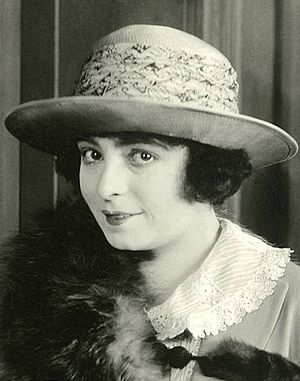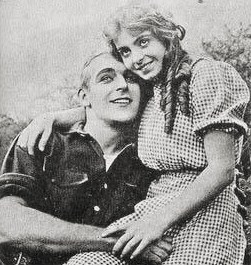Dorothy Davenport facts for kids
Quick facts for kids
Dorothy Davenport
|
|
|---|---|

Davenport in 1923
|
|
| Born | March 13, 1895 Boston, Massachusetts, U.S.
|
| Died | October 12, 1977 (aged 82) Los Angeles, California, U.S.
|
| Resting place | Forest Lawn Memorial Park, Glendale |
| Years active | 1910–1956 |
| Spouse(s) | |
| Children | 2 |
| Parent(s) | Harry Davenport Alice (Shepphard) Davenport |
Dorothy Davenport (born March 13, 1895 – died October 12, 1977) was an American actress, writer, film director, and producer. She came from a family of performers. Dorothy had her own acting career before she married the famous actor and director Wallace Reid in 1913.
After Wallace Reid passed away in 1923, Dorothy used her own experiences to help create the film Human Wreckage (1923). She was known as "Mrs. Wallace Reid" for this film. She promoted it as a movie with an important message. Dorothy continued to make films that focused on social issues, like Broken Laws (1924) and The Red Kimono (1925). Even though her own film company closed later, she kept working in movies. She directed her last film in 1934 but continued in other roles until 1956.
Early Life and Acting Career

Dorothy Davenport was born in Boston, Massachusetts, on March 13, 1895. Her family was full of actors. Her father, Harry Davenport, was a well-known Broadway star. Her mother, Alice Davenport, appeared in many films.
Dorothy's grandparents were also famous actors in the 1800s. Her aunt, Fanny Davenport, was considered a great stage actress. Dorothy started acting professionally at age six. By age fourteen, she was performing in burlesque shows.
She went to school in Brooklyn and Virginia. At 16, after performing in vaudeville, she moved to California. She wanted to become a film actress. Dorothy started her movie career with the Nestor Film Company. This company later became part of Universal Pictures. Her first known film role was in Life Cycle. Dorothy was also a skilled horse rider. She performed many of her own stunts in movies.
While working at Nestor, Dorothy met a young actor named Wallace Reid. They were acting together in a film. At first, she found his acting a bit difficult. But by the third day, she was very impressed with him. Both Dorothy and Wallace were important actors during Nestor's early years. They married in October 1913.
The next year, they worked on over one hundred films together. After this busy year, they left Universal for a short time. They returned to Universal in 1916. On June 18, 1917, Dorothy gave birth to their first son, Wallace Reid Jr.. She took a break from her career to be a full-time mother. In 1920, Dorothy and Wallace adopted their second child, a daughter named Betty Anna Reid.
Later Career and Social Films

After her husband Wallace Reid passed away, Dorothy worked with Thomas Ince. They co-produced the film Human Wreckage (1923). This movie starred James Kirkwood, Sr., Bessie Love, and Lucille Ricksen. Dorothy traveled with Human Wreckage to different places. She made personal appearances to promote the film.
She then made another film about social issues called Broken Laws in 1924. She was still billed as "Mrs. Wallace Reid" for this movie. Dorothy also produced The Red Kimono (1925), which was about a serious social problem. Both Human Wreckage and The Red Kimono were not allowed to be shown in the United Kingdom in 1926.
Dorothy continued to make films that focused on important social topics. These included Linda (1929), Sucker Money (1933), Road to Ruin (1934), and The Woman Condemned (1934). She worked as a producer, writer, and dialogue director. One of her last jobs was helping write the movie Footsteps in the Fog (1955). She also worked as a dialogue director for The First Traveling Saleslady (1956), which starred Ginger Rogers.
In the 1970s, near the end of her life, Dorothy had a copy of her husband's 1921 film Forever. She gave this film to a group that was planning a museum. However, the museum plans did not work out. Sadly, Dorothy's last copy of Wally's favorite movie was lost.
Dorothy Davenport passed away on October 12, 1977. She was 82 years old. She is buried with her husband at Forest Lawn Memorial Park, Glendale.
See also
 In Spanish: Dorothy Davenport para niños
In Spanish: Dorothy Davenport para niños

